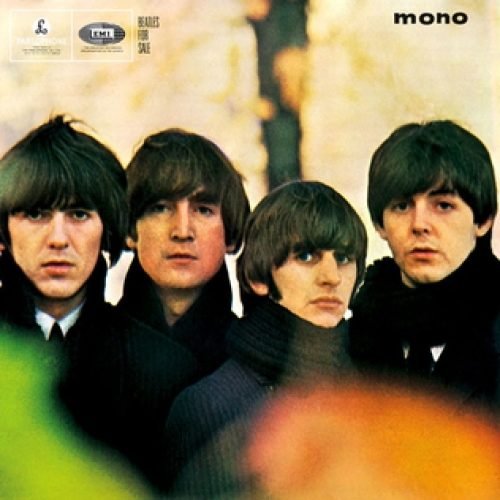Released in December 1964, Beatles for Sale marks a poignant chapter in The Beatles‘ illustrious discography. Situated amidst the whirlwind of Beatlemania that gripped the world, this album emerges not just as a collection of songs but as a reflective tapestry woven with the threads of fame, fatigue, and a burgeoning artistic restlessness. Coming off the heels of A Hard Day’s Night, their first album composed entirely of original material, Beatles for Sale did not merely continue the trajectory of pop-rock excellence but hinted at a deeper, more introspective direction.
By this point, The Beatles were not just chart-toppers but cultural icons whose every move was scrutinized and emulated. The weight of this fame began to seep into their music, reflecting a more nuanced and sometimes somber outlook on life. This album, nestled between the exuberance of their early work and the sophisticated experimentation that would characterize their later albums, serves as a bridge. It is both a culmination and a departure, deepening existing themes of love and loss while introducing a more reflective, even melancholic tone that would echo in their future projects.
Artistic Intentions
Artistically, The Beatles aimed to explore beyond the confines of their established sound with Beatles for Sale. The inclusion of cover songs alongside original compositions was a nod to their musical roots, showcasing influences ranging from Chuck Berry to Carl Perkins. Yet, it’s the original tracks where their artistic intentions shine brightest. Songs like “No Reply,” “I’m a Loser,” and “Eight Days a Week” signal a shift towards more personal, introspective lyrics. The Beatles were beginning to use their music as a mirror, reflecting their personal experiences and the complexity of their inner lives.
The album’s mix of rock ‘n’ roll vigor and folk-inspired introspection hints at the band’s evolving musical interests, foreshadowing the experimental phase that would reach its zenith in albums like Rubber Soul and Revolver. Through Beatles for Sale, The Beatles not only engaged with their immediate reality—grappling with the pressures of fame and the expectations it brought—but also laid the groundwork for their future as pioneers of musical innovation.
Sonic Exploration

The production of Beatles for Sale, overseen by the legendary George Martin, retains the crisp and clean quality characteristic of The Beatles’ early work. Yet, there is a discernible shift towards a more organic, slightly rawer sound compared to the polished sheen of A Hard Day’s Night. This choice in production subtly complements the album’s thematic exploration of weariness and introspection. The sound isn’t lo-fi by any standard, but it possesses a warmth and immediacy that brings the listener closer to the emotional states being explored. The recording techniques, innovative for the time, allowed for a richness in texture that served the album’s mood perfectly, balancing clarity with a touch of grit that mirrored the band’s evolving artistic direction.
Musical Arrangements
The musical arrangements on Beatles for Sale showcase The Beatles’ growing sophistication as musicians and arrangers. The album is notable for its expanded use of acoustic instruments, particularly the acoustic guitar, which plays a prominent role in songs like “I’m a Loser” and “No Reply.” This acoustic foundation lends a folk sensibility to the album, a notable departure from their primarily rock ‘n’ roll-oriented earlier albums.
Vocally, the album is rich in harmonies that are both complex and emotionally resonant, demonstrating the group’s unmatched vocal chemistry. “Eight Days a Week” stands out as a prime example, with its innovative fade-in intro—a rare technique at the time—and layered harmonies that underscore the song’s themes of love and devotion. The Beatles also experimented with vocal arrangements that conveyed a sense of vulnerability, aligning with the album’s introspective tone.
The integration of harmonica on tracks like “I’m a Loser” adds a bluesy, melancholic layer, while the sparing use of electric guitar solos and keyboard parts on other tracks contributes to the album’s diverse sound palette. These arrangements reflect The Beatles’ willingness to push beyond the boundaries of conventional pop music, incorporating elements from folk, country, and blues to create a sound that was both familiar and fresh.
Genre Elements
Beatles for Sale traverses a landscape of musical genres, touching upon rock ‘n’ roll, country, folk, and blues. This blending of styles was indicative of The Beatles’ broad musical influences and their desire to explore beyond the confines of pop music. The album’s foray into folk and country is particularly evident in tracks like “I Don’t Want to Spoil the Party” and “Baby’s in Black,” which incorporate country-inflected vocal harmonies and rhythmic structures. Meanwhile, songs such as “Rock and Roll Music” and “Words of Love” pay homage to the rock ‘n’ roll and early rockabilly that had initially inspired the band.
This eclectic mix of genres on Beatles for Sale does not come across as disjointed; rather, it demonstrates The Beatles’ adeptness at genre fusion, creating a cohesive sound that supports the album’s thematic undertones. The exploration of different musical styles not only showcases their versatility as musicians but also serves as a testament to their restlessness and desire to experiment and grow artistically. Through this sonic exploration, The Beatles were able to craft an album that was both a reflection of their current state of mind and a hint at the innovative directions their music would take in the coming years.
Lyrical Analysis

The central themes of Beatles for Sale revolve around vulnerability, introspection, and the duality of fame. Unlike the predominantly love-centered narratives of their earlier albums, this collection of songs delves into the complexities of human emotions and experiences. The Beatles touch on the pressures of their unprecedented fame (“No Reply”), the introspection and self-doubt brought on by their hectic lives (“I’m a Loser”), and the longing for authenticity amidst a whirlwind of public scrutiny (“Baby’s in Black”).
A recurring motif in the album is the theme of disillusionment, both in romantic relationships and in the broader context of their personal lives. This is encapsulated in “I’m a Loser,” where the blending of personal introspection with a broader sense of loss reflects a maturing lyrical depth. The album doesn’t shy away from exploring darker, more reflective territories, marking a significant evolution in The Beatles’ songwriting.
Lyrical Depth
The lyrics on Beatles for Sale showcase a leap towards greater complexity and poetic nuance. While there are straightforward, narrative-driven songs (“No Reply”), the album is marked by a move towards more abstract and metaphorical lyrics that invite multiple interpretations (“I’m a Loser,” “Eight Days a Week”). This lyrical depth is a testament to Lennon and McCartney’s growing sophistication as songwriters, able to weave personal experiences with broader existential themes in a way that feels both intimate and universally relatable.
The poetic nature of the album’s lyrics is further highlighted through the use of vivid imagery and metaphor. “Every Little Thing” and “What You’re Doing” exhibit a keen eye for detail and emotion, painting vivid pictures of everyday moments and feelings that resonate deeply with the listener. This approach not only adds layers of meaning to the songs but also showcases The Beatles’ ability to evolve their lyrical content beyond the simple love songs of their early years.
Emotional Impact
The emotional resonance of Beatles for Sale is one of its most compelling qualities. The album’s exploration of vulnerability, introspection, and the bittersweet aspects of fame strikes a chord that is both poignant and reflective. Songs like “No Reply” and “I’m a Loser” speak to the feeling of isolation and self-doubt, evoking empathy and a sense of solidarity with the listener. Meanwhile, tracks like “Eight Days a Week” offer a counterbalance, capturing the joy and exhilaration of love, thereby providing a spectrum of emotional experiences.
The nuanced emotional landscape of Beatles for Sale is a significant aspect of its lasting appeal. The album invites listeners into a more contemplative space, encouraging empathy and introspection. It stands out not just for its melodic and production innovations but for its ability to connect on a deeply emotional level, marking a pivotal moment in The Beatles’ evolution as artists who could capture the complexities of the human experience in their music. Through their lyrics, The Beatles crafted an album that resonates with listeners not just as a collection of songs, but as a reflective journey through the myriad emotions and experiences that define our lives.
Cohesion and Flow

Beatles for Sale demonstrates a thoughtful track progression that underscores both narrative and emotional development throughout the album. The opening track, “No Reply,” sets a tone of melancholy and introspection that resonates through subsequent songs, establishing an initial emotional depth that is both captivating and somber. This is gradually balanced with moments of uplift and classic Beatles charm, as seen in tracks like “Eight Days a Week.” The sequencing of songs creates a dynamic ebb and flow of moods, reflecting the complexities of the human experience—from the depths of despair to the heights of joy.
The album does not follow a linear narrative, but there is a palpable emotional progression. The journey from the introspective opening tracks to more upbeat, yet still reflective songs, creates a sense of movement and development. This progression is not just emotional but also musical, as the album explores a range of styles and influences. The closing tracks, while maintaining the album’s introspective tone, offer a sense of closure and reflection, encapsulating the introspective journey the album represents.
Thematic Consistency
In terms of thematic consistency, Beatles for Sale maintains a remarkable coherence despite its eclectic mix of genres and influences. The themes of vulnerability, the burdens of fame, and a yearning for authenticity thread through the album, providing a unified narrative that binds the collection of songs together. The Beatles manage to weave these themes not just through the lyrics but through the music itself—melding styles and sounds that reflect the album’s emotional and thematic core.
While the album does venture into different musical territories—from rock ‘n’ roll to country, folk, and blues—the transitions never feel jarring. Instead, these stylistic shifts complement the album’s exploration of complex emotions and experiences, enriching its narrative depth. The variation in musical styles serves as a backdrop to the album’s lyrical and thematic content, enhancing its emotional impact without undermining its cohesion.
However, it’s worth noting that the inclusion of cover songs alongside original compositions might seem, at first glance, to risk the album’s cohesion. Yet, The Beatles’ selection and interpretation of these covers are in harmony with the album’s overarching themes and mood, skillfully integrated to maintain the flow and enhance the narrative journey.
Standout Tracks and Moments
Key Tracks
“No Reply” opens the album with a narrative of missed connections and unspoken words, setting the tone for the introspective journey ahead. Its emotional depth, coupled with a memorable melody, makes it a standout track. The song’s structure, blending a melancholic narrative with an engaging, upbeat tempo, showcases The Beatles’ ability to weave complex emotions into accessible pop music.
“I’m a Loser” is notable for its candid lyrical content, reflecting a personal vulnerability that was rare in pop music at the time. The fusion of folk influences with rock ‘n’ roll energy exemplifies The Beatles’ evolving musical direction and their willingness to expose their insecurities through their music.
“Eight Days a Week” stands out for its innovative use of a fade-in introduction, a rarity in the music of its time. The song’s catchy melody, harmonious vocals, and optimistic love message offer a contrast to the album’s more introspective tracks, highlighting The Beatles’ versatility and their knack for crafting enduring pop anthems.
Memorable Moments
The opening chord of “No Reply” immediately captures the listener’s attention, setting a somber tone that beautifully contrasts with the upbeat rhythm of the song. This juxtaposition is a testament to The Beatles’ skill in crafting songs that are complex, both emotionally and musically.
The harmonica intro in “I’m a Loser” is not only a nod to their musical roots but also serves as an emotive precursor to the song’s introspective lyrics. This moment encapsulates the blend of melancholy and musicality that characterizes much of the album.
“Every Little Thing” contains a particularly poignant moment with its chorus, where the simple yet powerful declaration of love is underscored by a dramatic instrumental arrangement. This moment stands out for its emotional resonance and the way it showcases the band’s ability to use music to amplify the impact of their lyrics.
The vocal harmonies in “Eight Days a Week” are a defining feature of the track, demonstrating The Beatles’ unmatched cohesiveness and creativity as a vocal ensemble. The way their voices blend and play off each other provides not just a musical highlight, but a moment that captures the essence of their collaborative spirit.
The subtle yet effective use of silence before the final chorus in “What You’re Doing” serves as a powerful moment of anticipation and reflection, enhancing the song’s emotional impact. This masterful use of space within a song is a testament to The Beatles’ understanding of dynamics and tension in music.
These standout tracks and moments are representative of Beatles for Sale‘s artistic merit, innovation, and emotional depth. They not only highlight The Beatles’ evolving musicality and songwriting prowess but also underscore the album’s significance within their discography and the broader music landscape. Through these songs and moments, Beatles for Sale captures the essence of The Beatles at a pivotal point in their career, balancing the pressures of fame with a desire for artistic growth and expression.
Artistic Contribution and Innovation

Beatles for Sale occupies a unique place within not just the discography of The Beatles but also within the broader landscape of popular music. Released at a time when the music industry was dominated by singles and the allure of immediate hits, this album exemplified The Beatles’ commitment to the album as a cohesive artistic statement. It straddles the line between adhering to the pop-rock norms of its time and pushing against the boundaries of what popular music could convey in terms of emotional depth and musical diversity.
This album marked a transitional phase for The Beatles, where they began to explore more complex themes and experiment with a broader range of musical styles. By integrating elements of folk, country, and blues into their sound, Beatles for Sale challenged the prevailing norms of the pop genre, setting the stage for the more experimental and genre-defying work that would define their later career. In doing so, it contributed to a shift in the music industry, highlighting the album as a format for artistic expression and encouraging other artists to pursue greater creativity and depth in their own work.
Innovation
Thematic Depth
The album’s exploration of themes like vulnerability, disillusionment, and the complexities of fame represented a significant departure from the lighter, love-centric themes that characterized much of popular music at the time. This willingness to engage with more nuanced and introspective subject matter paved the way for future albums that would further explore the human condition, influencing countless artists to follow.
Musical Diversity
The Beatles’ incorporation of diverse musical influences, from the country twang in “I Don’t Want to Spoil the Party” to the folk-inspired acoustic arrangements in “I’m a Loser,” showcased an innovative blending of genres that was ahead of its time. This eclecticism not only enriched the album’s sonic landscape but also demonstrated the band’s versatility and willingness to experiment with different sounds.
Production Techniques
Under the guidance of producer George Martin, Beatles for Sale benefited from innovative production techniques that enhanced its emotional and sonic impact. From the pioneering use of the fade-in on “Eight Days a Week” to the nuanced layering of vocals and instruments, the album’s production played a crucial role in realizing The Beatles’ artistic vision, contributing to the evolution of recording practices in the industry.
Lyrical Sophistication
The lyrical content of Beatles for Sale represented a significant evolution in songwriting, with Lennon and McCartney delving into more complex and personal themes. This move towards greater lyrical sophistication challenged existing norms and expanded the possibilities for storytelling within the pop music format.
Through its thematic exploration, musical diversity, innovative production, and lyrical sophistication, Beatles for Sale made a lasting contribution to the music industry. It pushed the boundaries of the pop genre, encouraging artists to explore a wider range of emotions and themes in their music. As such, the album not only marked a pivotal moment in The Beatles’ career but also in the evolution of popular music as a whole, underscoring the band’s role as pioneers of artistic innovation and expression.
Closing Thoughts

Beatles for Sale is an album that vividly encapsulates a moment of transition and exploration for The Beatles, both musically and personally. Its strengths lie in its thematic depth, lyrical sophistication, and innovative blending of musical genres. The album showcases The Beatles’ willingness to explore the complexities of fame, love, and personal growth, making it a significant departure from their earlier work. The integration of folk, country, and blues influences not only demonstrates their musical versatility but also their desire to push the boundaries of pop music.
However, the album is not without its weaknesses. The inclusion of cover songs, while showcasing their roots and influences, sometimes interrupts the flow and cohesion of the original compositions. Furthermore, the experimentation and diversity in sound that would later define The Beatles’ most acclaimed works are only beginning to surface here, making Beatles for Sale feel like a transitional work rather than a fully realized artistic statement.
Official Rating
Given these considerations, a rating of 7 out of 10 for Beatles for Sale reflects its position as a pivotal, yet imperfect, chapter in The Beatles’ discography. The album stands as a testament to the band’s evolving artistry and willingness to confront the challenges of fame and personal change. Its exploration of deeper themes and integration of varied musical styles paved the way for the groundbreaking work that would follow, making it an essential, if not definitive, piece of The Beatles’ legacy.
